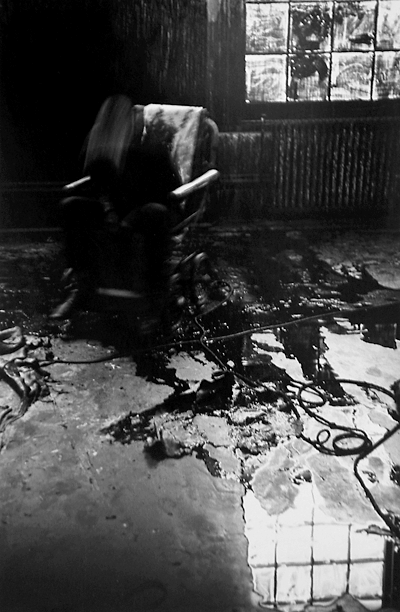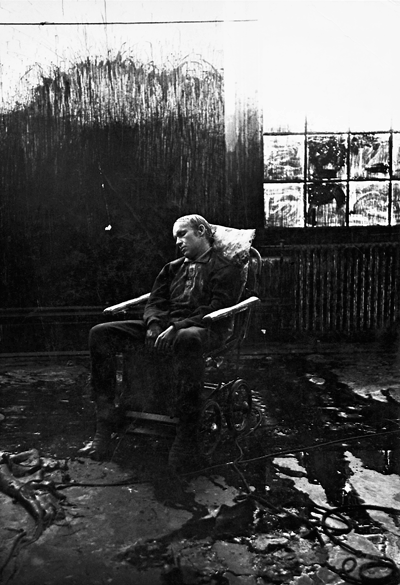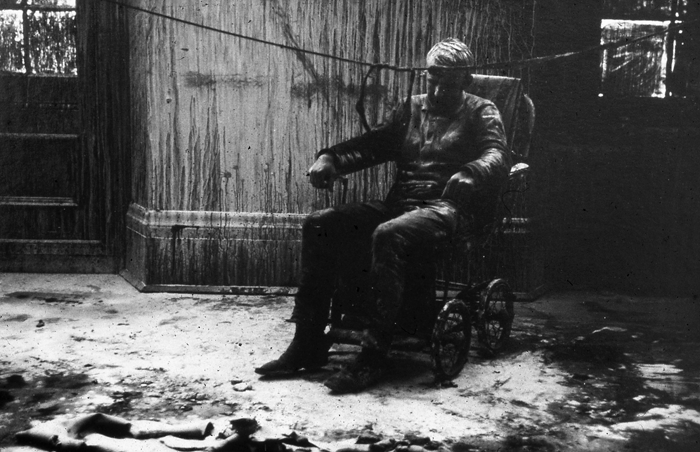


Stuart Brisley made these three works during 1981, although they concern events from three different dates during the 1970s. They were conceived as works in their own right and are not simply documentations of performances. Brisley is suspicious of documentation; he feels that it can invest an action with an inaccurate, sometimes mythical status. He is anxious however to have some record which amplifies the unique status of the brief existence of an event and gives it more than temporary form. He regards these pieces as having been ‘mediated to such an extent’ that they become ‘something else’, and stresses the importance for him of deliberately constructing the photographic work. He has chosen a size of photographic print that is ‘comfortable’ for the work, one that he regards as compatible with the work's intention: he would not, for example, choose a large print since he feels that this would cheapen the work.
'ZL 65 63 95 C’ concerns a performance made over seventeen days and nights in April and May 1972, at the opening exhibition, Three Life Situations, of Gallery House, 50 Princes Gate, London SW7, an alternative gallery space directed by Sigi Krauss in a period before the building was converted to serve as the new premises of the Goethe Institute. He shared the exhibition with Marc Chaimowicz and Gustav Metzger; each used a floor of the building, Brisley having the ground floor which was not changed in any way from the previous occupants' (the Mormons's) use of it for offices. (The partitions were subsequently removed for the exhibitions that followed.) The large back room was divided into two by a corridor; Brisley retained these elements, one space becoming a waiting room and the other the place in which the work was made. Spectators could not enter the artist's own space but could look into it through a slit that had been cut in the wall by the previous occupants. This was approximately 10 × 3in. and was at about 5ft. 6in. from the ground. It afforded a partial view of the room but obscured a view of equipment playing a recording of an amplified heartbeat. Above the slot Brisley had written NO REASON in careful Roman letters suggesting to the viewer that there was no rationale in the events that they were witnessing. In the room Brisley had a wheelchair and water, black paint and flour. He remained in the building for the whole length of the exhibition, usually sleeping in the basement (gallery administration area) thereby giving the illusion that he was in the working area throughout the show. During the seventeen days he used the materials to change the space from dry to wet, to create a dull atmosphere by painting both floor and walls before changing it with the flour to produce a white, dry, powdery surface.
One hour before the work was officially supposed to end Brisley began to knock down the wall which separated him from the audience; he did this because he sensed the work to be a failure (it could not have been a success in his view) and because he decided to intervene and end the work before the announced time. He wrote on the wall of the room ‘Not Achieved’, the date and time, the audience entered the room and the mystique faded. Brisley had suffered from sensory deprivation towards the end of the work, to such an extent that different people looking in through the slot looked the same and he was convinced that cameras were guns.
The title of the work derives from Brisley's National Insurance number; he changed his name to that number by deed poll for the duration of the exhibition. (His name was changed only whilst he was in 50 Princes Gate since he did not wish to create problems for his family.) This action was partly directed against bureaucracy but also as a reaction against performance becoming an individualistic, egotistical act. He describes wanting to reduce his personality, to create a situation where all the materials (including himself) used in making a work were given the same value. It was also an attempt to do nothing, to close the gap between what he saw as the opposed states of existing and acting. (Brisley sees his own development from making paintings specifically concerned with materials via constructive art (which concentrated on process) to a point where the work came out into the world and the artist himself performed it. He sees this piece as a further step in that process and emphasises the formal qualities that his work embodies.)
This work was the first occasion that Brisley performed alone; it followed performances in Edinburgh and London ‘You know it makes Sense’ (1972), and preceded a second work made in July 1972 at Gallery House which was used as the basis for his Arts Council film Arbeit macht Frei.
Published in:
The Tate Gallery 1980-82: Illustrated Catalogue of Acquisitions, London 1984